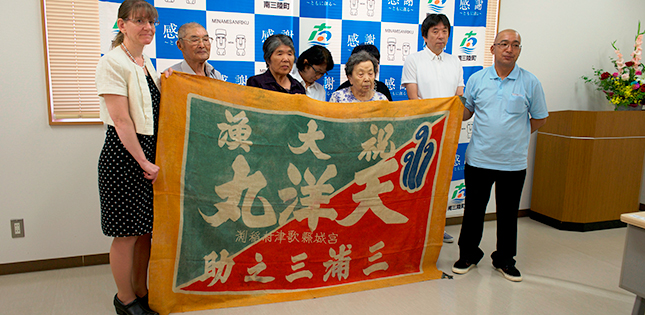The PR Division at Tohoku University is often the first port of call for those wanting to make enquiries about the university. More often than not, the caller wants us to provide them with information, sometimes souvenirs from the university.
But in January we received a request for assistance to have something returned. It was a flag that had been safely stored for over 70 years by a U.S. Navy veteran of World War II.
The appeal had come via the U.S. Veterans Administration on behalf of Mr. Peter Losh, who had obtained the flag in while stationed on the United States Aircraft Carrier Essex from 1941-1945. Losh, then Yeoman First Class Armin, was handed the flag by an American diver who'd retrieved it from a Japanese ship sunk in battle in the Pacific Ocean.
It was not uncommon in those days for soldiers to return home with "war souvenirs." Losh returned to his native Ohio with two: the flag and PTSD, at the time undiagnosable. He remembers looking at the flag when it dried out, and thinking it was pretty.
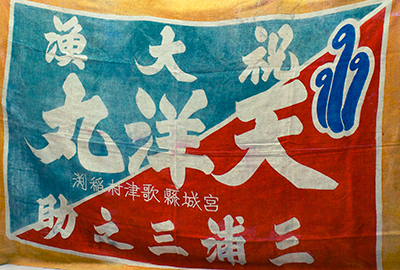 |
The vessel that the flag belonged to was a fishing boat conscripted into the war to provide supplies and transport to soldiers. Fishing boats were chosen for their sturdy engines and reliability in rough seas.
Like other traditional fishing flags, the one Losh obtained also bears the phrase "A big catch." Underneath is the name of the ship's commander, himself a fisherman, and his hometown - Sanosuke Miura, Utatsu Village, Miyagi Prefecture. These maritime banners were originally used as a fishing charm and hoisted by returning boats to indicate a large haul.
Through a series of detective work and the cooperation of many including the Miyagi Prefecture Fishing Association, Utatsu-Minami Sanriku Town Office and Consulate General of the U.S. in Sapporo, the Tohoku University PR Division was able to track down the only surviving child of Miura, and plans for the flag's repatriation began.
Six months after receiving the initial request, a representative from the Japanese Consulate-General in Detroit went to collect the flag from Losh at his retirement village in Dayton. It was then flown back by diplomatic pouch to Japan.
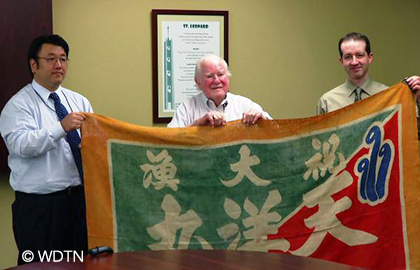 |
This week at a small ceremony held in Utatsu in Minamisanriku - Sanosuke Miura's hometown, a fishing village devastated by the tsunami that followed the 2011 Great Eastern Japan Earthquake - the flag was presented to Miura's family.
"When we heard about the flag we assumed it would be in tatters. We had no idea it would be so spectacular," said Sayoko Sasaki. She was six years old when her father was killed and was grateful to receive the memento of her father.
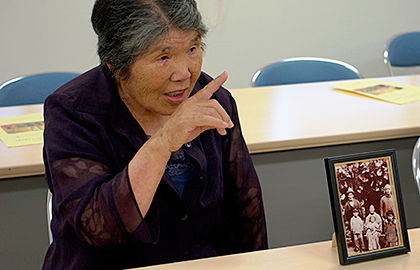 |
The flag was presented by U.S. Consul JoEllen Gorg, who remarked that the its homecoming was made possible through the goodwill that exists today between the U.S and Japan.
In contrast to the turbulent times of World War II, the U.S. Forces used their military might in the aftermath of the 2011 Great Eastern Japan earthquake to conduct large-scale aid activities in disaster affected areas of Japan.
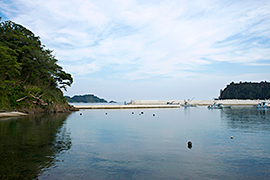 |
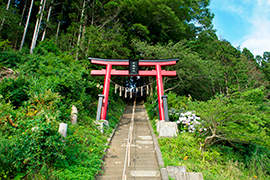 |
Utatsu is in fact famed for its 250 million-year-old fossil "Utatsusaurus." Named after the town, it is the earliest known form of an icthyopterian, a group of marine reptiles that lived in the Triassic period. The Tohoku University Museum has carried out restorative work on the fossil which was damaged in the 2011 disaster.
As the 70th anniversary of the end of the Second World War draws near, we are reminded of the horrors of the past, and the of the peaceful relations that the U.S. and Japan now enjoy. The return of the flag itself is a gesture of reconciliation from one old sailor to the family of another.
Contact:
Tohoku University International PR SectionTel: +81-22-217-4816
Fax: +81-22-217-4818
Email: public_relations
 gpr.tohoku.ac.jp
gpr.tohoku.ac.jp
